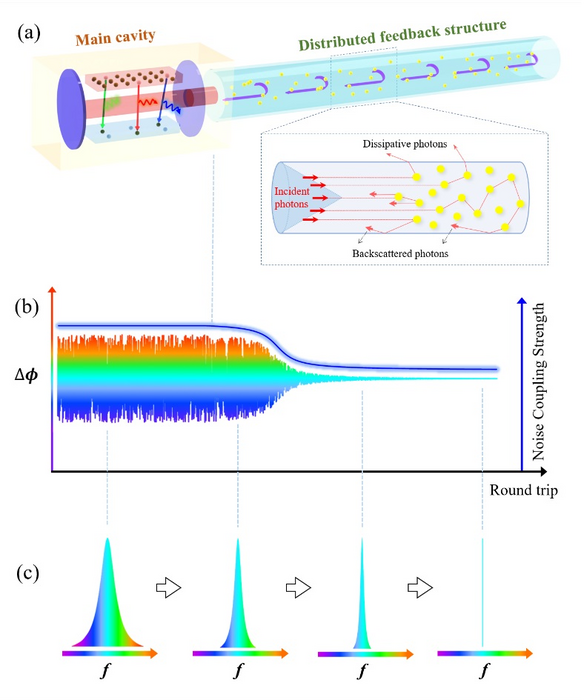The development of an ultra-high spectrum purity laser from a weak external distributed perturbation is covered in a recent article from Opto-Electronic Advances.
 Schematic diagram of laser spectral purification. Image Credit: OEA
Schematic diagram of laser spectral purification. Image Credit: OEA
In contrast to regular light sources, lasers have great coherence, pure monochromaticity, and good directionality. Since the invention of lasers, researchers have focused on laser parameter optimization to advance the growth of scientific innovations and commercial applications.
One of these is spectral purity, a crucial element in determining laser coherence.
The intensity and phase disruption of the spontaneous radiation will unavoidably impact the laser during laser operation, which is the physical essence of how spectral purity is impacted.
As a result, the output laser always exhibits a particular linewidth rather than being able to reach the ideal single frequency in the frequency domain.
The operation of the laser is also easily influenced by other elements, such as the pump source’s power jitter, temperature variations, vibrations, and luminescent gain medium lattice flaws, all of which have a significant impact on the laser’s linewidth and, consequently its coherence.
The two most popular ways to achieve narrow linewidth laser output are now servo-electrical feedback technology based on frequency stabilization control and fixed external-cavity optical feedback technology based on photon lifetime extension.
However, the servo-electrical feedback method necessitates external optical frequency detection and control devices with high precision and high sensitivity, the core of which is an expensive and massive high-stability frequency reference source, making it unsuitable for industrial applications.
Additionally, the fixed external-cavity optical feedback technology cannot automatically match changes in the main cavity laser wavelength since it is difficult to deeply compress laser linewidth under the assumption of single longitudinal mode operation.
Therefore, a challenging issue for contemporary scientific study and commercial applications is achieving deep compression of laser linewidth and self-adaptive wavelength under normal circumstances.
This led the authors of this article to investigate the wavelength self-adaptive spectral purification mechanism of ultra-narrow linewidth lasers and to propose a novel theory stating that the spontaneous radiation of the laser cavity can be efficaciously suppressed by the weak external distributed perturbation signal, thereby realizing the laser spectral deep purification under normal circumstances.
The linewidth compression experiment is conducted using the semiconductor DFB laser as the typical laser carrier, and a new laser configuration that combines the main cavity and the exterior cavity with distributed weak feedback is proposed as a result.
Under normal circumstances, a self-adaptive ultra-narrow linewidth laser output of 10 Hz or less is eventually attained.
Slowing down the rate at which the laser cavity couples with spontaneous radiation while it is operating allows for a significant reduction in the intrinsic linewidth of the laser, which is the primary function of distributed weak feedback in deeply compressing the laser linewidth.
The laser phase can be constantly and adaptively modified in the time domain since the distributed weak feedback’s single-point intensity is lower than that of spontaneous radiation.
Additionally, by reducing the rate of spontaneous emission coupling and avoiding the laser phase mutation and multi-longitudinal mode oscillation caused by the feedback of the fixed external cavity, the laser linewidth can be drastically reduced.
This work offers a strong theoretical and experimental foundation for the practical development of self-adaptive ultra-high spectrum purity lasers under ordinary use.
The concepts and laser configurations put forth by the research team not only have significant reference value for achieving the most extreme control of other laser characteristics, but they have also opened up new avenues for developing and getting various forms of high-coherence laser light sources.
The research team’s current focus is on the extreme regulation and control of laser time-frequency-spatial parameters based on high coherence, intending to advance the field of laser precision measurement toward greater accuracy, faster processing, and a wider measuring range.
Journal Reference:
Dang, L., et al. (2022) Ultra-high spectral purity laser derived from weak external distributed perturbation. Opto-Electronic Advances. doi:10.29026/oea.2023.210149.
Article Revisions
- Mar 11 2025 - Meta Title has been updated to fall inline with Google recommendations and a malformed link has been repaired.